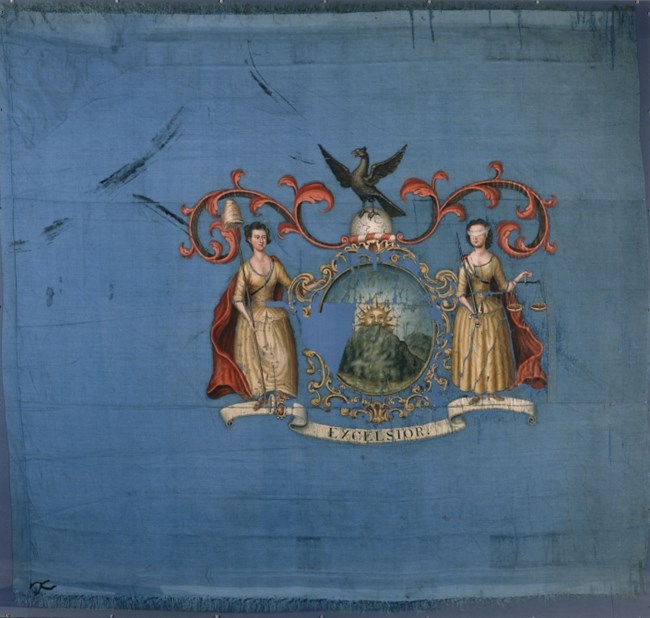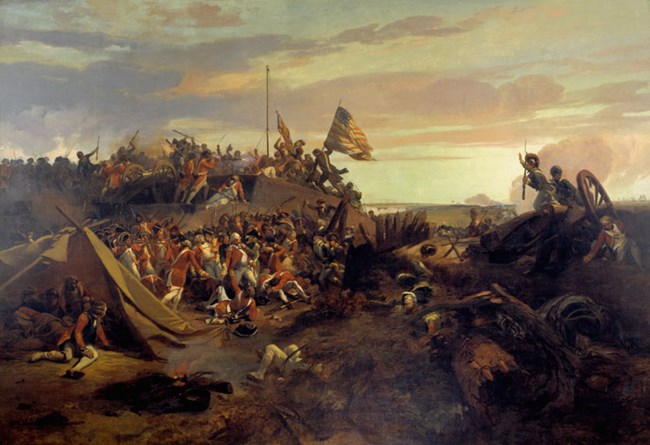Last updated: September 22, 2023
Article
The 3rd New York Regiment of the Continental Line 1777-1781

Gift of the estate of Catherine Gansevoort (Mrs. Abraham) Lansing. Courtesy of Albany Institute of History & Art
The first detachment of the 3rd NY, under Major Robert Cochran, reached Ft. Schyuler on April 12, 1777. Col. Gansevoort took command of the fort on May 3, and the remainder of the regiment (200 men) under Lt.Col. Willett, departed Constitution Island for Ft. Schuyler on May 12. Willett's detachment traveled up to Albany on three sloops, then marched from Schenectady to Ft. Schuyler, escorting the regiment's baggage train of seven wagons up to the post. Willett's detachment reached the fort on May 26, after having Capt. Dewitt's Company posted to Fort Dayton at German Flatts (this company remained at Ft. Dayton until July). The regiment was engaged in the constant work of repairing and rebuilding the fort from May through August. In August of 1777, the 3rd NY helped to successfully defend the fort in a 21 day siege by a British force of 2,000 regulars, Germans, loyalists, and allied Indians. During this time, a detachment of the regiment under Lt.Col. Willett took part in a raid on the main loyalist and Indian camps to the south and east of the fort. On the detachment's return to the fort, they skirmished with British troops attempting to cut off their retreat. Cannon fire from the fort, combined with the detachment's own 3 pound gun, finally drove the British off. This raid that destroyed the main loyalist and Indian camps, resulted in the further capture of a great deal of equipment and severely cooled the Indian's desire for further fighting. During this raid, the regiment did not lose a single man. After the siege, the regiment continued to garrison the fort through December of 1778, when it was relieved by the 1st NY Regiment, and was sent down into the lower Mohawk-upper Hudson Valley area.
In 1779, the 3rd NY Regiment received a gift from Col. Gansevoort in the form of a regimental flag. This flag, which was carried for the remainder of the war, later served as the basis for the present day New York State flag. On campaign, the regiment made up part of the troops committed to the various expeditions against British allied Six Nations settlements. In April 1779, the light infantry company returned to the Mohawk Valley as part of a detachment sent from Ft. Schuyler to destroy the principle Onondaga Indian villages. From August through September, the entire regiment was part of the Clinton-Sullivan expedition that destroyed the principle Cayuga and Seneca Indian villages in western New York. The regiment also participated in one major battle of the expedition at Newtown, which resulted in a major defeat for the Indians and the loyalist troops supporting them. In September, the 3rd NY once again returned to the Mohawk Valley, having been given the task of destroying the Mohawk village near Fort Hunter and retrieving the expedition's baggage. With the approach of winter, the regiment rejoined the main army under General Washington for the hard winter encampment of 1779-80 at Morristown, New Jersey.

Oil on canvas by Eugene-Louis Lami, 1840.
In the spring of 1782, the two New York regiments went into final quarters at New Windsor, New York, as the war wound down. In June, many of the men were furloughed home; and in November 1783, with the coming of peace, the men of the old 3rd NY Regiment were honorably discharged and became citizens of the new United States of America.

National Park Service/M. Colangelo
Visit our keyboard shortcuts docs for details
- Duration:
- 1 minute, 27 seconds
A typical day at the American Fort Schuyler during the Revolutionary War. All excerpts have been taken from the accounts of the soldiers who lived there.
Visit our keyboard shortcuts docs for details
- Duration:
- 1 minute, 20 seconds
A typical day at the American Fort Schuyler during the Revolutionary War. All excerpts have been taken from the accounts of the soldiers who lived there.
- Coulthart, Stephen B. Third New York Regiment of the Continental Line 1775-1788. Research article from the NPS-Ft. Stanwix NM Garrison Training Manual.
- Wright, Robert K. The Continental Army. United States Government Printing, 1983.
